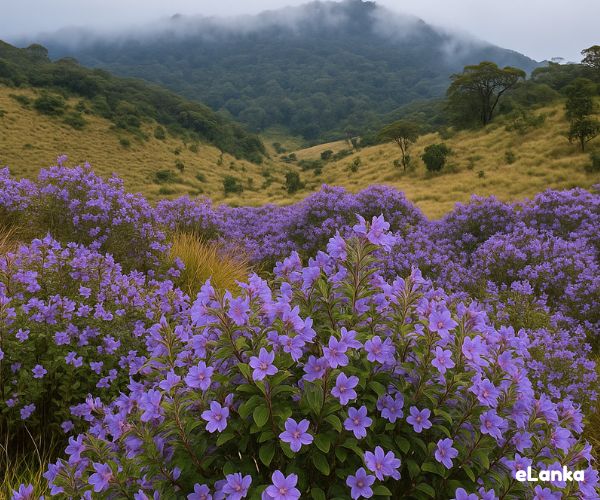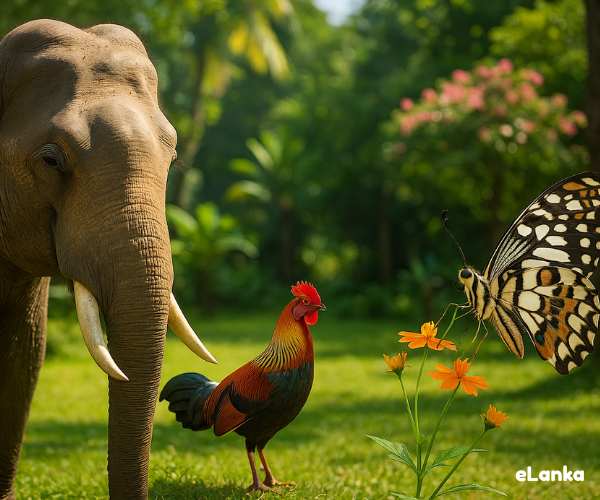Sri Lanka’s Floral Wonder: The 12-Year Bloom of Strobilanthes at Horton Plains – By Bhanuka – eLanka

High up in the central highlands of Sri Lanka lies Horton Plains National Park, a windswept plateau of grasslands, cloud forests, and misty peaks. For most of the year, its beauty lies in subtle shades of green, gold, and brown. But once in a remarkable twelve years, the landscape transforms into a living canvas of purples, blues, and violets. This breathtaking natural event is the mass flowering of Strobilanthes, a plant genus often referred to locally as “Nelu.”
A Botanical Rarity
The Strobilanthes genus is unusual in the plant world because of its synchronized flowering cycle. Certain species flower only once in a long interval — sometimes 6, 8, or 12 years — before setting seed and regenerating. In Sri Lanka, Strobilanthes pulcherrima and its relatives are known for this dramatic cycle. When the bloom occurs, thousands of shrubs across the highland forests burst into flower at the same time, carpeting hillsides in violet hues.
This phenomenon is not random. Botanists believe that such long flowering cycles evolved as a survival strategy. By flowering in unison, the plants ensure cross-pollination on a massive scale while overwhelming herbivores and seed predators. For visitors, it creates a once-in-a-generation natural spectacle that is as rare as it is beautiful.
Horton Plains: The Perfect Stage
Horton Plains, located in the Nuwara Eliya District and sitting at an elevation of over 2,000 meters, is the best place to witness this floral wonder. The park is already world-famous for attractions like World’s End escarpment, Baker’s Falls, and its unique montane grasslands. But during a Strobilanthes bloom year, the scenery becomes even more surreal.
Walking along trails such as the Thotupola Kanda route or the paths leading to Kirigalpotha, visitors may find entire stretches of forest understory glowing with violet blossoms. The contrast of these delicate flowers against the misty cloud forests and golden grasslands is striking.
More Than Just Flowers
The blooming event doesn’t only attract human admirers. It is also a magnet for pollinators. Bees, butterflies, and other insects descend on the flowers in vast numbers, creating a humming soundtrack to the visual spectacle. Birds too are drawn to the abundance of nectar and insects. In this way, the Strobilanthes bloom plays an important ecological role, providing food for multiple species at a time when resources might otherwise be scarce in the highlands.
Leopards, sambars, and smaller mammals of Horton Plains may also become more visible during the season, as the increase in insect and pollinator activity influences the movement of prey and predators alike.
Lessons from Abroad
Phenomena like this are not unique to Sri Lanka. In India’s Western Ghats, a related plant called Strobilanthes kunthiana (known as Neelakurinji) blooms once every 12 years, drawing thousands of visitors to places like Munnar. Japan’s cherry blossom season and the tulip festivals of the Netherlands have similarly become international attractions. Sri Lanka’s Nelu bloom has the same potential to be positioned as a seasonal tourism highlight — provided it is managed responsibly.
An Untapped Eco-Tourism Opportunity
Despite its rarity, the Nelu bloom is still little known outside naturalist circles. Few Sri Lankans are aware of it, and international promotion has been limited. With careful planning, this once-in-12-years spectacle could become a flagship eco-tourism event.
-
Community benefits: Villages near Ohiya, Pattipola, and Nuwara Eliya could see an increase in homestay bookings, transport services, and small businesses catering to visitors.
-
Education: Highlighting the bloom could help raise awareness about Sri Lanka’s montane ecosystems, which are among the most threatened habitats in the country.
-
Conservation funding: Special permits or seasonal park entry packages could channel funds directly into habitat protection and park management.
Balancing Tourism with Protection
Of course, such a delicate natural event must be treated with care. Horton Plains is already a popular hiking spot, and an influx of visitors during a bloom year could put pressure on trails and wildlife. Unregulated tourism could lead to trampling of vegetation, disturbance of pollinators, and pollution.
The key lies in controlled tourism:
-
Limiting visitor numbers during peak bloom weeks.
-
Offering guided tours rather than free roaming in sensitive areas.
-
Educating visitors on ecological etiquette.
-
Involving local communities and scientists in management decisions.
This way, the bloom can become a national celebration of biodiversity while safeguarding the very ecosystems that make it possible.
Why It Matters
Sri Lanka has marketed itself for years on its “sun, sand, and culture.” But as global travellers increasingly seek unique, nature-based experiences, events like the Strobilanthes bloom highlight another side of the island. Horton Plains can stand alongside the world’s great floral spectacles, offering a story that is both scientific and deeply cultural.
The next full bloom may not come again until the late 2030s. For anyone lucky enough to witness it, the memory will last a lifetime. More importantly, the way Sri Lanka chooses to manage and promote this event could shape its eco-tourism reputation for decades to come.
Conclusion
The mass blooming of Strobilanthes at Horton Plains is more than a floral show. It is a reminder of the delicate timing and interdependence of life in Sri Lanka’s highlands. It is an opportunity to showcase the island’s biodiversity to the world, and at the same time, a responsibility to conserve it.
As the violet blossoms spread across Horton Plains, they carry with them a message: nature’s wonders are fleeting, but with vision and care, their legacy can endure.






















